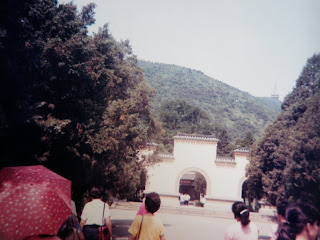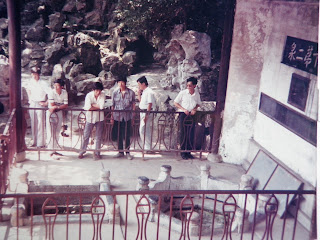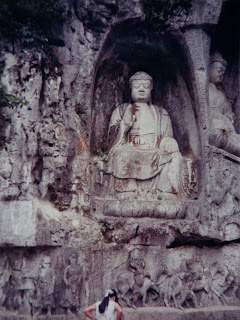Wuxi / 无锡:
Garden of Delight, 寄畅园:
(Ji Chang Yuan)
The Qianlong Emperor found the garden (from the Ming period 1368-1644) so entrancing that he used it as a model for the "Garden of Harmony and Pleasure" at his summer palace.
Garden of Delight: (Background: Tin Mountain), 寄畅园: (背景: 锡山)
Xihui Garden (Garden of Tin and Mercy), 錫惠公園:
It is at the foot of 2 charming hills Xishan and Huishan.
(One of the best scenic viewpoint for Lake Tai)
Mercy Mountain Spring (Second Most Beautiful Spring under the Heavens),
惠山泉 (天下第二泉):
Lake Tai, 太湖:
(Tai Hu; literally "Grand Lake") is a large lake in the Yangtze Delta plain, on the border of the Jiangsu and Zhejiang provinces. It is the third largest freshwater lake in China, after the Poyang and Dongting Lakes. The lake houses about 90 islands, ranging in size from a few square meters to several square miles.
Lake Tai is linked to the renowned Grand Canal. The lake is also the origin for a number of rivers, including Suzhou Creek.
Lake Tai, 太湖:
Turtle Head Peninsula, 鼋头渚公园:
(Yuan Tou Zhu gong yuan)
The tip of a peninsula in the north of the lake Tai, shaped like a turtle's head.The landscape here is quite fascinating, with steep cliffs and winding paths.
鼋头渚公园: 长春桥:
Lake Tai, 太湖:
Three Hill Isle, 三山岛 (三山公园):
a small garden floating on the water
Three Hill Isle, 三山岛 (三山公园):
______________________________________
Suzhou / 苏州:
The Lion Grove Garden, 狮子林园:
(Shi Zi Lin Yuan) It is famous for the large and labyrinthine grotto of taihu rock at the garden's center. The name of the garden derives from the shape of these rocks which are said to resemble lions. Currently, the Lion Grove Garden is one of the most popular spots for tourists in Suzhou. It is recognized with other classical Suzhou gardens as a UNESCO World Heritage Site since 1997.
The Humble Administrator's Garden, 拙政园:
(Zhuozheng Yuan) is one of four great Chinese gardens. At 51,950 m2 it is the largest garden in Suzhou and generally considered the finest garden in southern China. In 1997, Zhuozheng Yuan, along with other classical gardens of Suzhou was proclaimed a UNESCO World Heritage Site.
The Beisi Pagoda, 北寺塔 (报恩寺塔):
(Beisi Ta) or North Temple Pagoda is a Chinese pagoda located at Bao'en Temple (Bao'en Si) (hence it is also called Bao'en Temple Pagoda). It is said to have first been constructed during the Three Kingdoms period by the order of Sun Quan, the king of Wu, who prayed for the happiness of his mother.
West Garden,西园:
______________________________
Hangshou / 杭州:
One of the most renowned and prosperous cities of China for much of the last 1,000 years, Hangzhou is also well-known for its beautiful natural scenery, with the West Lake (Xi Hu, 西湖) as the most well-known location.
The Venetian Marco Polo supposedly visited Hangzhou in the late 13th century. His book refers to the city as "beyond dispute the finest and the noblest in the world."
West Lake, 西湖:
湖上风荷:
锦带桥:
Broken Bridge, 断桥:
Bai Causeway, 白堤:
(背景: 宝石山 与 保俶塔)
(background: Baochu Pagoda on Baoshi or Precious Stone Hill; one of the landmarks of the West Lake, the pagoda was originally built in 963)
West Lake, 西湖:
Xiao Ying Zhou, 小瀛州:
(one of 3 small man made islands on the West Lake. The other 2 are: 湖心亭 and 阮公墩)
湖中有湖:
岛中有岛:
Three Ponds Mirroring the Moon , 三潭印月:
Fish Viewing at the Flower Pond , 花港观鱼:
Liuhe Pagoda, 六和塔:
(built in 1165 during the Song Dynasty)
Dreaming of the Tiger Spring, 虎跑泉踪:
虎跑: 猛虎:
Dreaming of the Tiger Spring (虎跑梦泉; hupaomengquan) is a spring and scenic, as well as historic, location in southwestern Hangzhou
The water from the spring itself seeps out from quartzite and is regarded as the third best in China.The water is popular for brewing teas, such as the local specialty, Longjing tea.
Tiger spring is also the burial place of monk Jigong.
Panda at the zoo, 动物园: 熊猫:
Feilai Feng: Elder Li's Pagoda, 飞来峰: 理公塔:
(In the Wulin Mountains (武林山), which also features a large number of grottos and religious rock carvings, the most famous of which is the Feilai Feng (飞来峰; literally "the peak that flew hither").The largest stone pagoda in this scenic area, Elder Li's Pagoda (理公塔), houses the ashes of Huili, the Indian monk who founded Lingyin)
Religious rock carving:
金光洞:
Lingyin Temple,灵隐寺:
Founded in 328 AD during the Eastern Jin Dynasty by monk Huili, who came from India, it is one of the largest and wealthiest Buddhist temples in China, and contains numerous pagodas and Budddhist grottoes.
Grand Hall of the Great Sage, 大雄宝殿:
Longjing Well, 龙井:
Jade Springs, 玉泉:
Fish Viewing at the Jade Springs , 玉泉: 鱼乐园:
Yue Fei’s Mausoleum, 岳坟:
Yue Fei Temple,岳王庙:

Jingci Temple,净慈寺:
(located at the foot of Huiri Peak of Nanping Hill)
It hosts one of Ten Scenes of West Lake, "Evening Bell Ringing at the Nanping Hill"(南屏晚钟).
南屏晚钟:
(a newly forged copper bell, weighing over 100 Kilograms. On it carved The Lotus Sutra (妙法莲花经), with 68,000 characters)
聚景园:
A typical Chinese garden's window decoration in Hangzhou:
Chinese sayings:
"Be born in Suzhou, live in Hangzhou, eat in Guangzhou, die in Liuzhou." (生在苏州, 活在杭州, 吃在广州, 死在柳州) (The meaning here lies in the fact that Suzhou was renowned for its beautiful and highly civilized and educated citizens, Hangzhou for its scenery, Guangzhou for its food, and Liuzhou for its nanmu wood coffins which supposedly halted the decay of the body. )
"Heaven Above, Suzhou and Hangzhou below." (上有天堂,下有苏杭)
(This phrase has a similar meaning to the English phrases "heaven on Earth" or "God's country".)
























































